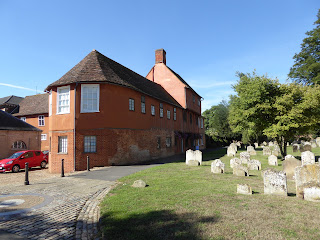Sunday, 12 August 2018
Sunday.
A week or so ago I published pictures of the Lavenham Guildhall, which was built around the year 1520, and said that our guildhall here in Highdale was a couple of centuries earlier, or thereabouts, but not so well known as the Laveham one. Took the above and below photoes of it yesterday morning. It is double jettied as you can see, and I asked one of our local 'experts' about it a few years ago, and got the answer that we don't really know when it was built, but that most of it was standing on the same spot around the year 1370! It is still used as local government offices. In fact a great many Suffolk villages still have large old buildings known as 'the Guildhall' at the centre of the village. Mostly they are old 'wool towns'. They prospered until the mid 1300s. We had (in 1349 and 1350) two very bad years for the Black Death, after which the sheep were moved across to the Midlands, and our Suffolk villages went into decline. This 'potted history ' is a little over simplified, but is basicallly what happened here. It has left us with some lovely old half timbered buildings in the middle of gloriously picturesque villages. I'm a Norfolk man by birth, but I've been exploring Suffolk all my adult life, and it's never ceased to surprise and delight me.
Subscribe to:
Post Comments (Atom)


5 comments:
It's a wonderful edifice and it's splendid that it's still in use. I showed it to Tim when we visited your area in November '16. As you say, there are so many fine old buildings. A lot of Bungay was destroyed in the Great Fire of 1688, so most of our oldest buildings are Georgian.
That, of course, does not include your remains of Bungay's Bigod Castle (which I always admire ) ?
I always admired Bigod's sanguine but unpolitic attitude to the 'King of Cockney'. But a sturdy castle might make its inhabitant less than deferential to royalty.
Notes from Wikipedia:-
Originally this was a Norman castle built by Roger Bigod of Norfolk, around 1100, which took advantage of the protection given by the curve of the River Waveney.[1] Roger's son, Hugh Bigod, was a prominent player in the civil war years of the Anarchy, and his loyalty was called into question during the early years of the reign of Henry II.[1] Henry confiscated Bungay, returning it in 1164.[1] Hugh went on to build a large square Norman keep on the site in 1165.[2] It is not recorded how much it cost to build the keep, but Hugh Braun who led the excavations at the castle in the 1930s estimated that it would have cost around £1,400.[3] Hugh ended up on the losing side in the Revolt of 1173–1174, Bungay was besieged, mined and ultimately destroyed by royal forces. The site was subsequently restored yet again to the Bigods and was further developed in 1294 by Roger Bigod, 5th Earl of Norfolk, who probably built the massive gate towers on the site.[1] Roger fell out with Edward I and after his death the castle reverted to the Crown, falling into disrepair and ruin.[1] From 1483, it was primarily owned by the Dukes of Norfolk until the 20th century.
Post a Comment